When a new lifter finally gets a kettlebell in their hands, the swing is typically one of the first exercises they try. But it shouldn’t be. The swing is arguably the most popular kettlebell exercise and it might actually be the movement that’s synonymous with the oddly shaped weight, but the swing isn’t exactly a simple exercise to perform.
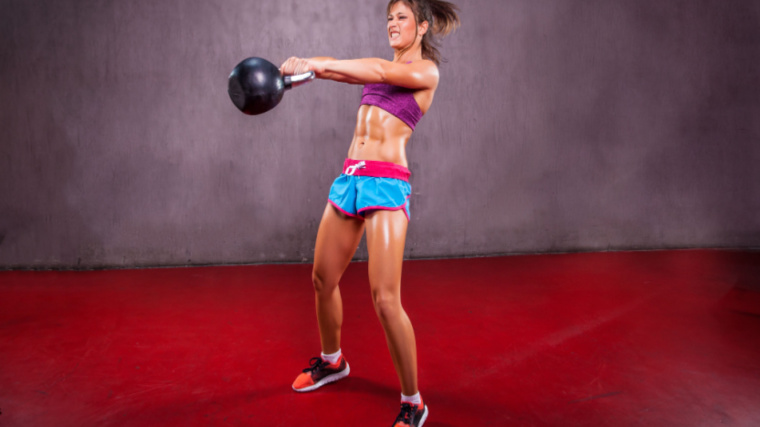
Swings require a base level of muscular conditioning, coordination, and timing to reap major benefits. Beginning your kettlebell experience with the swing is like learning to cook an omelet before you can manage scrambled eggs. Instead, consider the kettlebell deadlift as your introductory kettlebell exercise.
The kettlebell deadlift will build strength, size, and conditioning in your lower body, core, back, and arms. The deadlift also teaches you how to properly hinge at your hips, which is the most efficient way to recruit your glutes and hamstrings for powerful lifts (including, you guessed it, the swing). Here are more reasons to get started with the real fundamental kettlebell movement — the kettlebell deadlift.
Kettlebell Deadlift
- How to Do the Kettlebell Deadlift
- Kettlebell Deadlift Mistakes to Avoid
- How to Progress the Kettlebell Deadlift
- Benefits of the Kettlebell Deadlift
- Muscles Worked by the Kettlebell Deadlift
- How to Program the Kettlebell Deadlift
- Kettlebell Deadlift Variations
- Frequently Asked Questions
Kettlebell Deadlift Demonstration
Watch coach Alex McBrairty showcase picture perfect technique with a kettlebell deadlift. Even though he’s specifically demonstrating a wide-stance, or sumo-style, kettlebell deadlift, the overall form and body positioning will be the same when using a more moderate foot position.
Get a visualization of the movement and then continue learning tips, cues, and more form advice.
How to Do the Kettlebell Deadlift Step By Step
The kettlebell deadlift is a foundational movement. It teaches the hip hinge movement pattern, which coordinates force production through your hamstrings, glutes, and lower back. The kettlebell deadlift is also, quite practically, a safe and efficient way to lift any load off the ground.
Step 1 — Address the Kettlebell
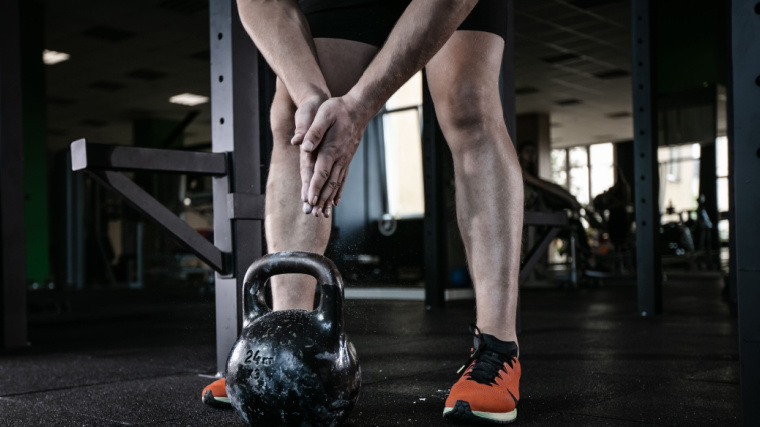
No, not by tipping your hat and cheerily saying “Hello, bell.” Stand in front of the kettlebell with your feet roughly shoulder-width apart. Position the center of the weight between your toes and midfoot. The weight’s handle should be pointing toward each foot, not front and back.
Form Tip: If you have a larger frame, a long torso, or short arms, you may need to adjust the kettlebell’s starting position. If possible, perform one or two repetitions with a relatively light weight and adjust your stance to achieve a comfortable and powerful starting position.
Step 2 — Grab the Weight and Drop Your Hips
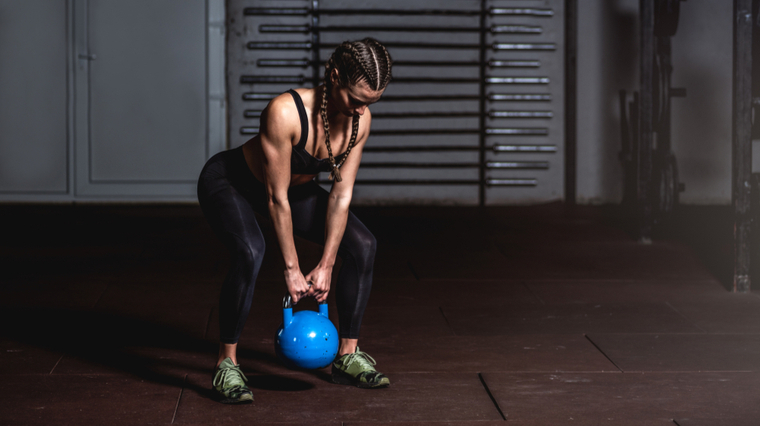
Drive your glutes backward and bend at your hips to reach toward the weight. Grab the top handle with a palms-down grip using both hands, with your thumbs nearly touching each other. Keep your torso straight and bend your legs until your shoulders are in line above the weight and your hips are below your shoulders. Keep your head neutral — avoid any instinct to look straight ahead, which could strain your neck.
Feel tension in your hamstring and glute muscles. Squeeze the handle and rotate at your wrists and shoulders to point your biceps forward. This should also drive your shoulder blades down toward your hips and put tension on your lat muscles, which improves your upper body stability.
Form Tip: If the kettlebell handle is too narrow to comfortably fit both hands, leave your pinkies running along the outer edge or “horns” of the kettlebell, pointing to the ground. It may feel awkward, but it shouldn’t affect performance of the exercise or impact your grip strength to any large degree.
Step 3 — Drive Up to a Standing Position
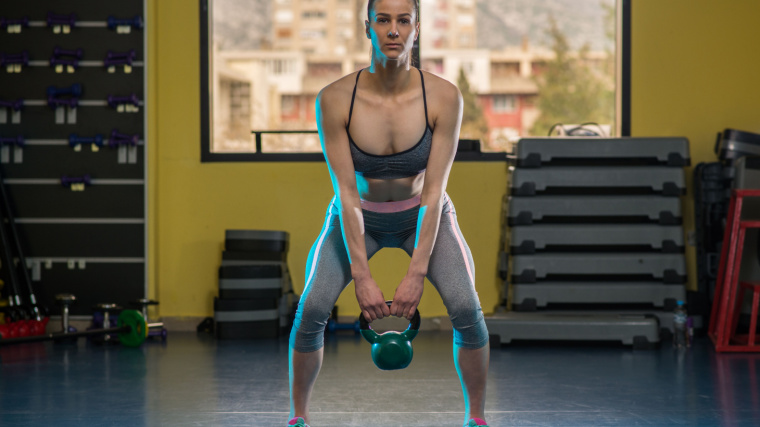
Squeeze your grip and pull your shoulders toward your hips to feel tension on your lat muscles. Drive your feet through the ground, pull your shoulders back, and push your hips forward to stand up to a locked out position. Keep your arms straight and bring the kettlebell up along your legs.
In the locked out position, the weight should be resting near the front of your thighs with your arms locked straight. Take a quick breath in, brace your core, and reverse the motion — driving your hips back and returning the weight to the ground under control.
Form Tip: Aim to stand up straight without leaning back excessively at the top. Flex your glutes, abs, and arms to ensure a mostly straight lockout. This should prevent too much backward “overcorrection,” which can strain your lower back.
Kettlebell Deadlift Mistakes to Avoid
While the kettlebell deadlift is a fundamental and relatively basic movement, there are several technique errors that can be counterproductive. Here’s what to avoid as you perform the exercise.
Pulling with a Rounded Back
This is a capital mistake for any deadlift variation, including the kettlebell deadlift. Having your back in a rounded position as you drive up in a deadlift puts the supportive muscles of your spine in a poor leverage position, which transfers stress to your vertebral discs.
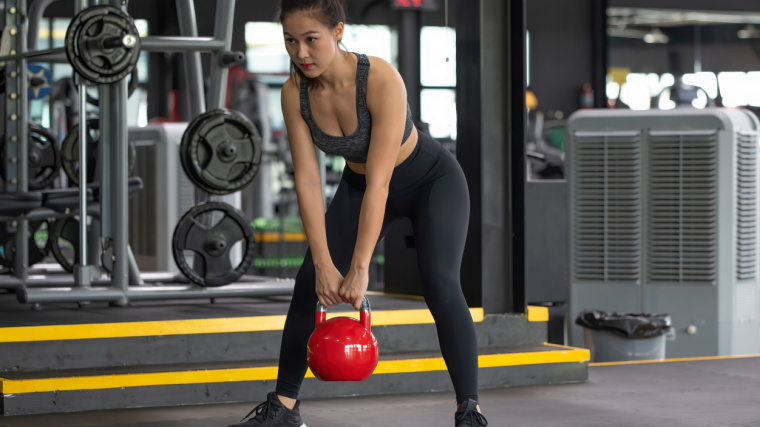
A rounded back position also puts your body in an inefficient position to transfer force from your lower body to your upper body, which will affect how much power you can produce.
Avoid it: Stay stiff from your hips to your neck. Before lifting the weight off the ground, flex your core and lat muscles to create tension throughout your entire torso.
Pulling with Bent Arms
Similar to the issue regarding a rounded back, you want to avoid performing any deadlift variation with bent arms. If your arms are less than straight as you lift, you shift stress onto your elbow joints rather than your muscles. You also decrease the amount of force you can transfer from your back and shoulders into your grip, which will decrease your strength.
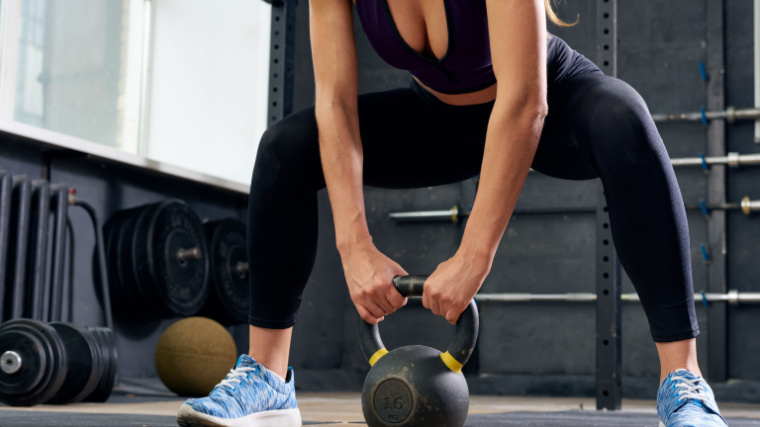
There’s also a chance of straining your biceps muscle, which will be partially contracted when your arm is bent, compared to a more stable and supported straight-arm position.
Avoid it: Before each repetition, contract your triceps and try to “aim” your biceps forward by rotating at your wrists and shoulders. These small steps should force your arms into a straightened position, or highlight when your arms are bent.
How to Progress the Kettlebell Deadlift
Some lifters may not be able to perform a kettlebell deadlift with good technique due to their limb leverages, current strength levels, or other factors. Other lifters may consider the exercise “too fundamental” and not challenging enough. Rather than neglecting the exercise, some simple adjustments can be made to accommodate lifters of any experience level or capability.
Elevated Kettlebell Deadlift
The most efficient adjustment to the exercise is raising the kettlebell onto a sturdy step or series of weight plates. This reduces the range of motion, making the exercise more accessible for lifters whose limb lengths make the standard exercise technique uncomfortable.
The elevated kettlebell deadlift is also an excellent choice if you only have access to a limited selection of kettlebell weights and the “lightest” available is beyond your current capacity. Gradually increasing an exercise’s range of motion, rather than increasing the weight used, is an effective technique for building strength and muscle. (1)
Kettlebell Deficit Deadlift
Performing the kettlebell deadlift while standing on a slightly elevated platform is another way of manipulating the range of motion, this time making the exercise more challenging.
Placing stable weight plates or sturdy platforms (of identical heights) under each foot will increase muscle recruitment by requiring your body to move through a longer range of motion. When lifting from a deficit, a little elevation goes a long way. Don’t be too aggressive by starting with significant heights. One to two inches (such as a 25-pound weight plate) is an effective way to begin.
Benefits of the Kettlebell Deadlift
The kettlebell deadlift can serve a number of roles in your training plan. Whether it’s part of a kettlebell-only workout or incorporated into other training, this exercise can deliver a range of results.
Lower Body Strength
The kettlebell deadlift can be used to establish a base level of strength in the posterior chain — your lower back, glutes, and hamstrings. Even though the exercise isn’t often performed with very heavy weights, the applied tension will build strength and muscular conditioning in the target muscles. This strength can carry over to other deadlift variations, as well as a variety of lower body exercises.
Lower Body Size
The glutes and hamstrings, in particular, are strongly recruited during the kettlebell deadlift. (2) The quadriceps and back are also involved, and all of these activated muscles will be stimulated for muscle growth during the exercise. Any deadlift variations, including the kettlebell deadlift, can be very effectively used as part of any bodybuilding-style leg day.
Practicing the Hip Hinge Movement
Because the kettlebell deadlift requires a single piece of training equipment, it’s a convenient way to train the hip hinge movement pattern or general deadlift technique. While the kettlebell itself is unique to the movement, the overall body positioning, necessary tension, and step by step technique cues will carry over to barbell deadlifts.
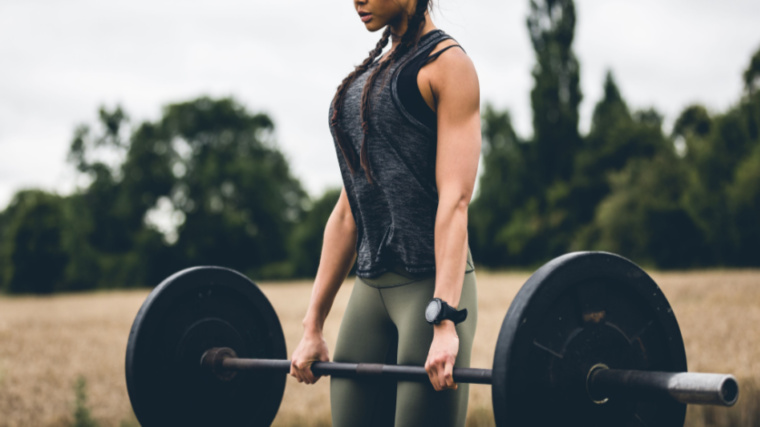
This makes the kettlebell deadlift an efficient way to train the movement without needing to place the body under heavy loads, which can be useful for general mobility training, exercise warm-ups, or technique practice.
Muscles Worked by the Kettlebell Deadlift
The kettlebell deadlift is typically considered a lower body exercise, but like many other deadlift variations, it can only be performed by coordinating actions between your legs and upper body. Here’s a closer look at everything that’s working during a set.
Legs
Your legs are the primary targeted muscle group during the kettlebell deadlift. More specifically, your glutes and hamstrings are strongly recruited to lift the weight and extend your hips into the locked out position. Your quadriceps play a role in the lower portion of the lift, initially bringing the weight off the ground.
Upper Back
The upper back muscles (including your trapezius, rhomboids, and rear deltoids) play a role in controlling your posture during the kettlebell deadlift. Because your hands are close together while holding the weight, your shoulders are pulled slightly forward. Your upper back is activated to resist this action by pulling your shoulder blades into a more stable position.
Core
Your abs and lower back work in unison to provide a safe, strong, and stable body position during the kettlebell deadlift. Your core is the key to transferring force from your lower body through your upper body to move the weight. Your lower back, in particular, is heavily activated to achieve a fully upright, locked out position.
Grip
Many kettlebell manufacturers design their handles to be slightly thicker than the average barbell or dumbbell. Training with thick-handled implements can increase the activation of forearm muscles, which can benefit grip strength development.
How to Program the Kettlebell Deadlift
Few lifters will have access to kettlebells heavy enough to perform extremely heavy, low repetition training. There are still effective ways to fit the kettlebell deadlift into your training plan for optimal results.
Moderate Weight, Low to Moderate Repetition
The kettlebell deadlift can be ideally trained for size and strength using a classic set and rep scheme of three to four sets of five to eight reps. A moderate load should be used to avoid muscular failure. This keeps the emphasis on crisp technique and a high rate of force production rather than cumulative fatigue from a long time under tension, which could compromise technique.
Light Weight, Moderate Repetition
The kettlebell deadlift can be performed as a type of warm-up movement using a relatively light weight for two to three sets of eight to 10 reps. With this approach, you can drill the hip hinge movement and prepare your hips, hamstrings, glutes, and involved muscles without excessive fatigue.
Kettlebell Deadlift Variations
The kettlebell deadlift can deliver a range of benefits from just a few simple modifications and variations. Here are some of the most basic and most efficient variations to trigger more results.
Kettlebell Suitcase Deadlift
Performing a single-arm kettlebell deadlift may sound like an intuitive variation, but more importantly than using only one arm is keeping the weight next to your body rather than in front of it.
Shifting the weight from in front of your body to alongside your leg creates a more intense challenge to your core. This lights up your obliques (side abs) and spinal erectors (lower back) to prevent your body from leaning toward the weight as you perform the exercise.
Kettlebell Stiff-Leg Deadlift
By keeping your legs stiff or nearly straight (not entirely locked out), you shift muscle recruitment to more strongly emphasize your hamstrings, glutes, and lower back. This technique adjustment will slightly reduce the amount of weight you can lift, but will increase the stress put on the target muscles.
With the kettlebell stiff-leg deadlift, it’s essential that you maintain a stiff lower back and not round forward to reach the weight, which would increase strain on your vertebrae.
Kettlebell Single-Leg Single-Arm Romanian Deadlift
This might win the award for longest exercise name, but the results are also award-worthy. The “KBSLSARDL” is a performance-based movement focused on using perfect technique and full-body tension rather than lifting heavy weight or targeting one specific body part.
Holding the weight in one arm while supporting your entire body on one leg turns the exercise into a total-body test of strength and stability. Muscles from your ankle to your neck to your grip will fire nonstop as you fight to remain in control of the weight.
FAQs
Is the kettlebell deadlift very different from the dumbbell deadlift?
Both movements can either be alternatives to, or progressions toward, the standard barbell deadlift. The key difference, beyond the specific implements (one kettlebell versus two dumbbells), is that the dumbbell deadlift is typically performed with the weights held at your sides. This can reduce some strain on the lower back by shifting your center of gravity and dispersing stress.
The kettlebell deadlift is performed with the weight in front of your body, which is more similar to the conventional barbell deadlift. The exercises are otherwise very similar and can be used nearly interchangeably, as your needs require.
I only have access to one kettlebell. How should I use the kettlebell deadlift?
This is a common situation with home gym-based lifters who may have limited equipment. If you only have a single, fixed-weight kettlebell, you can incorporate the kettlebell deadlift with adjusted programming methods.
Manipulate the sets and reps depending on your current strength level relative to the weight you have available. If you can perform more than 10 repetitions, consider adding an additional set or reducing rest times to make the exercise more challenging. You can also perform the kettlebell deficit deadlift as a more challenging progression.
If you can perform fewer than five repetitions with your weight, consider using the elevated kettlebell deadlift while progressively decreasing the height. You can also perform multiple sets of one to two repetitions, to build strength while maintaining good technique.
Pick Up the Kettlebell
The kettlebell swing is highly effective and versatile exercise, but you need to walk before you run. Or, more accurately, you need to deadlift before you swing. Take the time to master this fundamental movement and it will serve you will for building a base of muscle, strength, and conditioning, as well as fine-tuning your hip hinge to boost your barbell lifts.
References
- Whaley, Orrin & Larson, Abigail & DeBeliso, Mark. (2020). Progressive Movement Training: An Analysis Of Its Effects On Muscular Strength And Power Development: 881 Board #7 May 27 1:30 PM – 3:00 PM. Medicine & Science in Sports & Exercise. 52. 210-211. 10.1249/01.mss.0000675840.15637.df.
- Martín-Fuentes, I., Oliva-Lozano, J. M., & Muyor, J. M. (2020). Electromyographic activity in deadlift exercise and its variants. A systematic review. PloS one, 15(2), e0229507. https://doi.org/10.1371/journal.pone.0229507
Featured Image: Srdjan Randjelovic / Shutterstock
